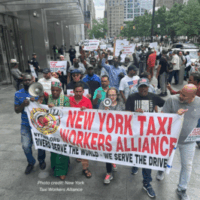NELP’s report calls for updated protections, regulation of ‘bossware’ and support for worker organizing to address dangers posed by digital surveillance and automated decision systems.
NEW YORK—A new report from the National Employment Law Project highlights the threat to workers posed by employers’ excessive and inappropriate use of digital workplace technologies to monitor and manage their workforces. Companies are increasingly using “bossware” to monitor workers’ actions, schedule shifts, assign tasks, set pay, and evaluate and discipline workers—but too often without transparency, safeguards for accuracy, or recourse for workers who’ve been wronged.
NELP’s report, When ‘Bossware’ Manages Workers: A Policy Agenda to Stop Digital Surveillance and Automated-Decision-System Abuses, warns that the unchecked misuse of these technologies jeopardizes workers’ autonomy, safety, job security, and overall well-being.
“Machines mismanaging human workers. People being surveilled and micro-managed almost as if they are robots. This is our current reality, but we have largely neglected to update our legal protections to keep pace with these changes,” said Irene Tung, NELP senior researcher and policy analyst and lead author of the report. “We must take immediate and decisive action to mitigate the harmful impacts of digital surveillance and automated decision systems, especially as new technologies like AI grow more sophisticated. We need policies that ensure technology improves job quality rather than degrades it.”
NELP’s report highlights two types of bossware: (1) workplace digital surveillance tools, and (2) automated decision systems. These technologies are now deeply embedded across various management functions, from scheduling and task allocation to performance evaluations and discipline. Often acting as hidden overseers, they are directly linked to a range of harmful practices, including exploitative pay and scheduling, and violations of fundamental worker rights.
NELP’s report identifies these critical areas where the proliferation of bossware has intensified existing workplace problems:
- Harmful Disciplinary Practices and Job Precarity: Leading to unfair discipline, reduced job security, and a constant climate of fear.
- Loss of Autonomy and Deskilling of Jobs: Diminishing workers’ control over their tasks and devaluing their professional expertise.
- Unhealthy or Dangerous Conditions: Exacerbating physical injuries, mental stress, and burnout due to relentless algorithmic demands.
- Work Fissuring and Independent Contractor Misclassification: Enabling companies to control workers while denying employment relationships and associated protections.
- Exploitative Pay and Scheduling Practices: Driving down wages, facilitating wage theft, and creating unstable, unpredictable work hours.
- Barriers to Accessing Social Insurance and Work-Related Benefits: Making it harder for workers to qualify for or claim essential benefits like unemployment insurance.
- Discrimination and Systemic Inequity: Embedding and amplifying biases, leading to discriminatory outcomes for protected classes.
- Suppression of Worker Collective Action and Bargaining: Interfering with workers’ rights to organize and engage in collective action.
Although the prevalence of bossware in U.S. workplaces is difficult to quantify, initial findings show these digital tools are not only common among large corporations like Uber and Amazon, but are also extensively utilized through hundreds of smaller vendors, including staffing agencies, temporary firms, and specialized platforms.
Employers have largely adopted these digital surveillance and automated management tools without meaningful negotiation with workers or robust regulation. The current policy landscape does not adequately address the growing use of these dangerous technologies, leaving workers vulnerable. As powerful corporate and financial actors drive the integration of bossware into more sectors and jobs, policymakers have a responsibility to act urgently and establish guardrails.
The report underscores the critical need for a balanced approach, where robust public policy works in tandem with strong worker organizations to ensure that technology serves the interests of workers and communities, rather than solely maximizing corporate profits.
NELP concludes the report by offering detailed policy proposals in the following areas:
- Update and expand existing workplace protections to account for the harms caused by bossware, including health and safety regulations, fair pay, and workers’ rights to organize.
- Directly regulate bossware with particular attention to its use in performance evaluations, pay-setting, and disciplinary actions to prevent abuses of power.
- Ensure broad worker access to labor and employment rights.
- Strengthen countervailing forces by supporting worker organizations and unions to hold employers accountable.
###


